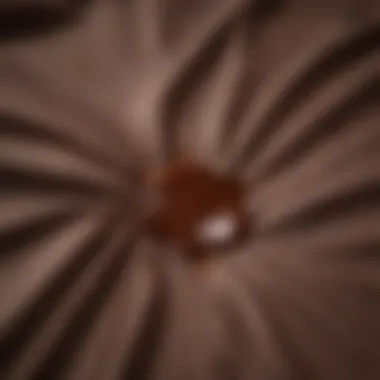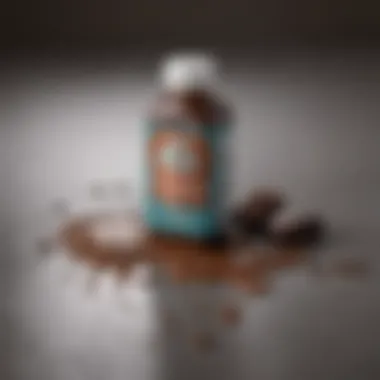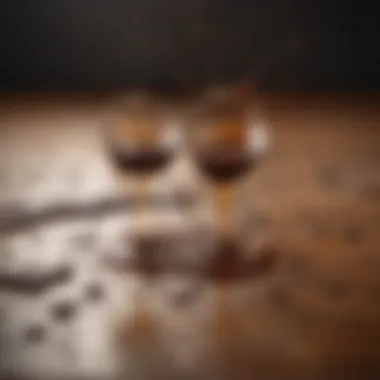Effective Strategies for Removing Dried Chocolate Stains


Intro
Dried chocolate stains present a unique challenge for garment care. Unlike fresh stains, which can be treated more easily, dried chocolate seeps into the fabric fibers and can become nearly permanent. This article serves as a guide to the various strategies for removing these stubborn stains. We will explore chemical interactions in stain removal, practical methods using common household items, and commercial products that can assist in your efforts. Additionally, we will discuss preventive measures to help you avoid such nuisances in the future while maintaining the integrity of your fabric.
This knowledge is crucial for anyone who values their clothing. Chocolate, while delicious, can wreak havoc if spills occur. Recognizing how to address these stains promptly can save you time, effort, and resources in the long run.
Let’s delve into the essential topics that will help you tackle dried chocolate stains effectively.
Understanding Chocolate Stains
When discussing the removal of chocolate stains from clothing, it is crucial to first comprehend the nature of these stains. Understanding chocolate stains involves a few critical aspects including their composition and the factors that influence how they interact with different fabrics. This foundational knowledge can significantly affect the efficacy of your stain removal efforts and ensure that you do not inadvertently damage the fabric while trying to remove the stain.
Chocolate is a complex substance, consisting of cocoa solids, cocoa butter, sugar, and sometimes milk. Each of these components reacts differently when it comes in contact with fabrics. Additionally, recognizing the importance of quick action and the right techniques can make a significant difference. Knowing the underlying characteristics of chocolate stains can guide one in selecting the most appropriate cleaning strategy for the specific type of fabric involved.
Nature of Chocolate Stains
Chocolate stains present unique challenges due to their oily nature, primarily caused by cocoa butter. This component not only makes chocolate delicious but also creates a residue that can be quite bothersome once it dries. The sugar content can become sticky, attracting dirt and grime which can further complicate the removal process.
When chocolate dries, it can darken, making it even more visible against lighter fabrics, and potentially leading to permanent discoloration if not treated properly and promptly. Temperature also influences how chocolate behaves, as heat can cause it to set deeper into the fibers of the fabric. Therefore, understanding the nature of chocolate stains indicates the importance of prompt and correct treatment to avoid lasting damage.
Types of Fabrics Affected
Different fabrics respond variably to chocolate stains. Some fabrics, like cotton and polyester, are more resilient and can withstand harsher treatments if needed. However, delicate materials such as silk or wool require gentle care to avoid destruction. Here are some common fabrics affected by chocolate stains:
- Cotton: Generally easy to clean and holds up well against various cleaning methods.
- Polyester: Resilient, but certain detergents may affect its sheen.
- Silk: Very delicate; requires gentle methods and immediate attention.
- Wool: Absorbs stains deeply; gentle treatment is necessary to avoid felting.
Being aware of these variances in fabric types is essential. It aids in choosing appropriate cleaning methods that protect garment integrity while effectively addressing the stain.
"Understanding the composition and properties of chocolate stains is crucial in developing effective removal methods."
Initial Steps Before Treatment
Understanding the significance of initial steps before treating dried chocolate stains is crucial for success. Taking the right actions at this stage can greatly influence the efficacy of the removal process and help preserve the integrity of the fabric. These steps are essential to ensure that the stain is addressed properly and does not set further into the fibers of the clothing.
First and foremost, it's vital to approach any stain with care, as different fabrics and chocolate compositions can react differently to treatments. If initial steps are ignored, further damage can occur, making the situation worse.
Assess the Stain
To effectively deal with a chocolate stain, an accurate assessment is required. Begin by identifying the type of chocolate involved. Is it dark, milk, or white chocolate? Each type may have slightly different compositions and can react differently to cleaning methods.
Next, consider how long the stain has been present. Fresh stains are generally easier to manage than those that have dried and set in. For dried stains, a gentle touch is necessary to avoid damaging the fabric while attempting to lift the stain.


Examine the fabric composition as well. Certain materials such as silk or wool may require specialized treatment, while synthetic fabrics typically handle more aggressive cleaning methods without adverse effects.
Gather Necessary Tools and Ingredients
Having the right tools and ingredients ready can streamline the stain removal process. Here is a list of essential items:
- Cold Water: Always use cold water for rinsing, as hot water can set the stain.
- Liquid Detergent: A gentle yet effective option will help break down the chocolate residue.
- Baking Soda: Acts as a mild abrasive while also deodorizing fabrics.
- White Vinegar: Useful for neutralizing odors and can aid in breaking down the stain.
- Commercial Stain Remover: Consider one that is specifically designed for food stains.
- Clean White Cloths: For blotting and applying cleansers without transferring color or residues.
- Soft Brush: Useful for gently agitating the stain without damaging fabric.
By being prepared with these tools and ingredients, the process of removing dried chocolate stains becomes less daunting, thus improving the likelihood of success in restoring beloved clothing items.
Methods for Removing Dried Chocolate Stains
Chocolate stains can be a considerable challenge, particularly when they have dried and set into the fabric. Knowing the right methods can make a significant difference in the effectiveness of stain removal. Each technique not only varies in effectiveness but also in the potential impact it can have on different types of fabrics.
Implementing these methods can help ensure that clothing remains in good condition while successfully addressing stains. Being informed about these strategies allows individuals to act promptly and confidently, maintaining the integrity of their garments. Here, we delve into various effective methods for tackling dried chocolate stains.
Cold Water Soak Technique
The cold water soak technique serves as an excellent preliminary step in the stain removal process. Begin by turning the affected garment inside out. This approach prevents the chocolate from spreading further into the fabric. Next, submerge the stained area in cold water. It is crucial to use cold water rather than hot or warm water, as heat can set the chocolate stain further.
Leave the fabric soaking for at least 30 minutes, allowing the water to loosen the chocolate particles. After soaking, gently agitate the fabric. Avoid scrubbing too hard to prevent damage. After this step, rinse under cold water to wash away any excess chocolate.
Pre-Treatment with Liquid Detergent
Liquid detergent can be a powerful ally when handling dried chocolate stains. After soaking the fabric, apply a small amount of liquid detergent directly onto the stain. Allow it to penetrate the fibers for about 5 to 10 minutes. This time frame allows the detergent to break down the oils and sugars present in the chocolate.
Use your fingers or a soft brush to gently work the detergent into the stained area. After this pre-treatment, rinse the fabric under cold water. This two-step process enhances the chances of complete stain removal, making it more effective when it is followed by further cleaning measures.
Using Baking Soda Paste
Baking soda is recognized not only for its baking qualities but also for its stain-fighting abilities. To create a baking soda paste, mix equal parts of baking soda and water. Apply the paste generously over the chocolate stain.
Allow the paste to sit for about 15 to 20 minutes. The alkaline nature of baking soda helps to lift and absorb the chocolate particles. After the waiting period, rinse the fabric thoroughly under cold water. The chemical reaction will assist in breaking down the chocolate residue.
Application of White Vinegar
White vinegar is another effective solution for treating dried chocolate stains. It works particularly well to neutralize residue left after the previous treatment steps. Mix an equal ratio of white vinegar and water in a bowl. Use a clean cloth or sponge to dab the mixture onto the stain.
Let it sit for around 10 minutes. The acetic acid in the vinegar helps break down the chocolate. After ten minutes, rinse the fabric with cold water to remove the vinegar solution and the loosened stain effectively.
Using Commercial Stain Removers


When home methods do not provide satisfactory results, considering a commercial stain remover may be necessary. Products like OxiClean MaxForce, Zout, or Shout Advanced Gel are formulated to combat tough stains.
Follow the instructions provided on the product label closely. Generally, applying the product directly to the stain and allowing it to sit for a specified amount of time yields the best results.
It's advisable to test any commercial stain remover on a hidden area of the garment first to ensure compatibility with the fabric's color and texture.
Final Rinse and Drying Techniques
After any stain removal procedure, a thorough rinse is essential. Use cold water to rinse the fabric until all traces of the cleaning agents are eliminated. This step is crucial to prevent any leftover chemicals from affecting the material over time. Once rinsed, air drying is preferable. Avoid placing the fabric in a dryer until confirming that the stain is entirely gone, as heat can solidify any remaining chocolate residue, making it harder to remove.
Preventive Measures for the Future
Taking preventive measures is fundamentally important for managing chocolate stains. Prevention reduces the frustration and effort required to remove stubborn stains later. Understanding how to respond immediately to spills and selecting the right fabrics can significantly mitigate the impact of chocolate stains on clothing. These strategies empower individuals to act quickly and effectively, preserving the quality of their garments and their peace of mind.
Immediate Response to Stains
Swift action upon noticing a chocolate stain is critical. The sooner the treatment begins, the higher the chances of complete removal. First, gently scrape off any excess chocolate from the fabric with a dull knife or spoon. This helps avoid spreading the stain further. Next, run cold water through the back of the stained area. This technique pushes the chocolate out of the fibers instead of driving it deeper into the fabric.
After rinsing, blot the area with a cloth to absorb any remaining moisture. Applying a liquid dish soap or a stain remover at this stage can enhance the removal process. Choose a stain remover that is appropriate for the fabric type. If time allows, allow the product to sit for a few minutes before rinsing again with cold water. The key here is not to use hot water, as it can set the stain.
Choosing Stain-Resistant Fabrics
When purchasing clothing, considering fabrics that repel stains can save a lot of trouble in the long run. Fabrics such as polyester, nylon, or specially treated cotton can resist stains more effectively than traditional materials. These synthetic fibers often have a smoother surface, reducing the chance of stains penetrating deeply.
Before making a purchase, check for stain-resistant finishes. Many manufacturers offer treatments designed to repel liquids and stains. Although such fabrics may come at a higher initial cost, they can save money and effort over time by requiring less frequent cleaning.
Thus, when you select your wardrobe, consider prioritizing stain-resistant fabrics, especially for children's clothing or any garments likely to encounter food products during events or outings. By opting for these materials, you can greatly reduce the likelihood of enduring chocolate and other stubborn stains.
Chemical Considerations in Stain Removal
When faced with dried chocolate stains on clothing, understanding the chemical processes involved in stain removal becomes essential. This knowledge helps in selecting the right methods and products for effective removal while preserving the integrity of fabrics. Knowing how various substances interact with stains can lead to better informed decisions during the cleaning process.
Understanding Stain Chemistry
Stains are caused by substances that attach themselves to fabric fibers. Chocolate consists of fats, sugars, and proteins. Each of these components requires different approaches for removal. For instance, the fats can repel water, making it harder to wash them away without the right chemicals. You may need a solvent for effective stain treatment. Liquid detergents are designed with surfactants, which break down grease and oils, thereby assisting in the removal of fat-based stains like chocolate.
It's also worth noting that some enzymatic detergents specifically target protein-based stains, making them beneficial for chocolate stains which contain both fat and protein. Choosing the right product can drastically affect your success in removing the stain.
The Role of Temperature in Stain Removal
Temperature plays a key role in how effectively stains are removed. Generally, higher temperatures increase the effectiveness of cleaning agents, but it can also set certain stains if not handled properly. For example, using hot water can help loosen the fat content in dried chocolate, allowing for easier removal. However, if the fabric is made from delicate materials like silk or wool, high temperatures could damage the fibers.


In contrast, warm or cold water may be less efficient in breaking down the sludge that dried chocolate leaves. Thus, you should consider the fabric type when deciding the washing temperature.
Important Note: Always check the care label on the clothing before deciding the temperature to use for washing.
Maintaining Fabric Integrity
Maintaining fabric integrity is a crucial aspect when dealing with chocolate stains on clothing. It ensures that the garments retain their original appearance, texture, and strength after the cleaning process. Failing to preserve fabric integrity may lead to further damages like fading, fraying, or even weakening of the material itself.
When selecting the appropriate stain removal strategies, consider each fabric's characteristics. Different types of fabrics react uniquely to various cleaning agents and methods. For instance, natural fibers such as cotton and linen might tolerate higher heat and harsher chemicals, while delicate fabrics like silk and wool require gentler treatment to avoid irreversible damage.
Additionally, it is critical to follow the care instructions provided by the garment labels. Washing at the correct temperature, using suitable detergents, and choosing appropriate drying options are vital steps that contribute to maintaining fabric integrity.
"A mistake in cleaning can make a beloved garment unwearable. Proper care starts with understanding what works best for your fabric."
When you prioritise maintaining fabric integrity, you not only extend the life of your clothes but also save money in the long run by avoiding premature replacements. Given the investment in clothing and the importance of appearance, it should matter significantly to keep them looking fresh and whole.
Testing Fabric Compatibility
Before applying any stain removal method, testing fabric compatibility is essential. This involves checking how a specific fabric reacts to a cleaning product or technique. Conducting tests helps to prevent unwanted outcomes, such as discoloration or structural changes in the fabric.
To carry out a compatibility test, you can perform the following steps:
- Select an inconspicuous area: Pick a small, hidden spot on the garment to conduct your test. This strategy prevents visible damage to the more apparent areas of the fabric.
- Apply a small amount of cleaning solution: Dab a tiny amount of your chosen cleaning solution onto the fabric. Use a cotton swab or clean cloth for precision.
- Wait and observe: After applying the solution, wait a few minutes and check for any adverse reactions, such as discoloration or deterioration.
- Rinse thoroughly: If no changes are visible after some time, rinse the area with water to ensure that no residue remains from the cleaning solution.
Following these steps ensures that you maintain the integrity of the fabric while effectively addressing the stain.
Gentle Washing Practices
Gentle washing practices are vital when dealing with stained fabrics, especially those that are prone to damage. Some approaches can significantly enhance the cleaning process while safeguarding the fabric. Here are several practices to consider:
- Use cold water: Cold water is less likely to set stains and is more gentle on fabric than hot water. This is particularly important for delicate materials.
- Select a mild detergent: Opt for a gentle, pH-balanced detergent. Strong chemical agents can compromise fabric integrity over time.
- Avoid excessive agitation: When washing, refrain from aggressive scrubbing or twisting. Instead, gently agitate the fabric to avoid causing premature wear.
- Line dry when possible: Instead of using a tumble dryer, air drying is often less harsh on clothes. It helps maintain the size and shape of the garments.
Ending
To effectively manage dried chocolate stains on clothing, understanding the significance of comprehensive strategies is crucial. This article has offered a multi-faceted approach to stain removal, from initial assessment to the application of diverse methods for treating stubborn blemishes. With insights into chemical considerations and fabric care, readers can now approach cleaning with both knowledge and confidence.
When dealing with chocolate stains, immediate action is undeniably beneficial, as addressing issues early often leads to better outcomes. However, even in cases where prevention falls short, the various techniques outlined provide a systematic way to tackle these stains.
The benefits of mastering these techniques extend beyond simple stain removal. They enhance the lifespan of your clothing by maintaining fabric integrity and ensuring your wardrobe remains polished. Parents and individuals who prioritize appearance can greatly benefit from knowing how to treat routine mishaps such as chocolate stains. A well-informed approach not only saves garments but also cultivates a sense of competence in handling such challenges.
"Awareness of the correct methods and their scientific rationale can transform a frustrating ordeal into a manageable task."
In summary, the techniques shared in this guide are essential for anyone looking to uphold a standard of cleanliness in their clothing. They empower readers to combat chocolate stains with precision and resolve, ultimately leading to a more maintainable and aesthetically pleasing wardrobe.
Summary of Effective Strategies
To recapitulate, the key strategies for removing dried chocolate stains effectively include:
- Assessing the stain properly to determine the best removal method.
- Gathering the right tools and ingredients, which may include cold water, liquid detergent, baking soda, vinegar, or commercial stain removers.
- Implementing techniques such as the cold water soak, pre-treatment with detergent, and using baking soda paste to break down the stain.
- Using white vinegar as a natural cleanser to neutralize odors and assist in lifting the stain.
- Considering the application of specialized commercial stain removers, when home methods fall short.
- Following up with a final rinse and proper drying techniques, to ensure that the cleaning process retains fabric quality and prevents damage.



